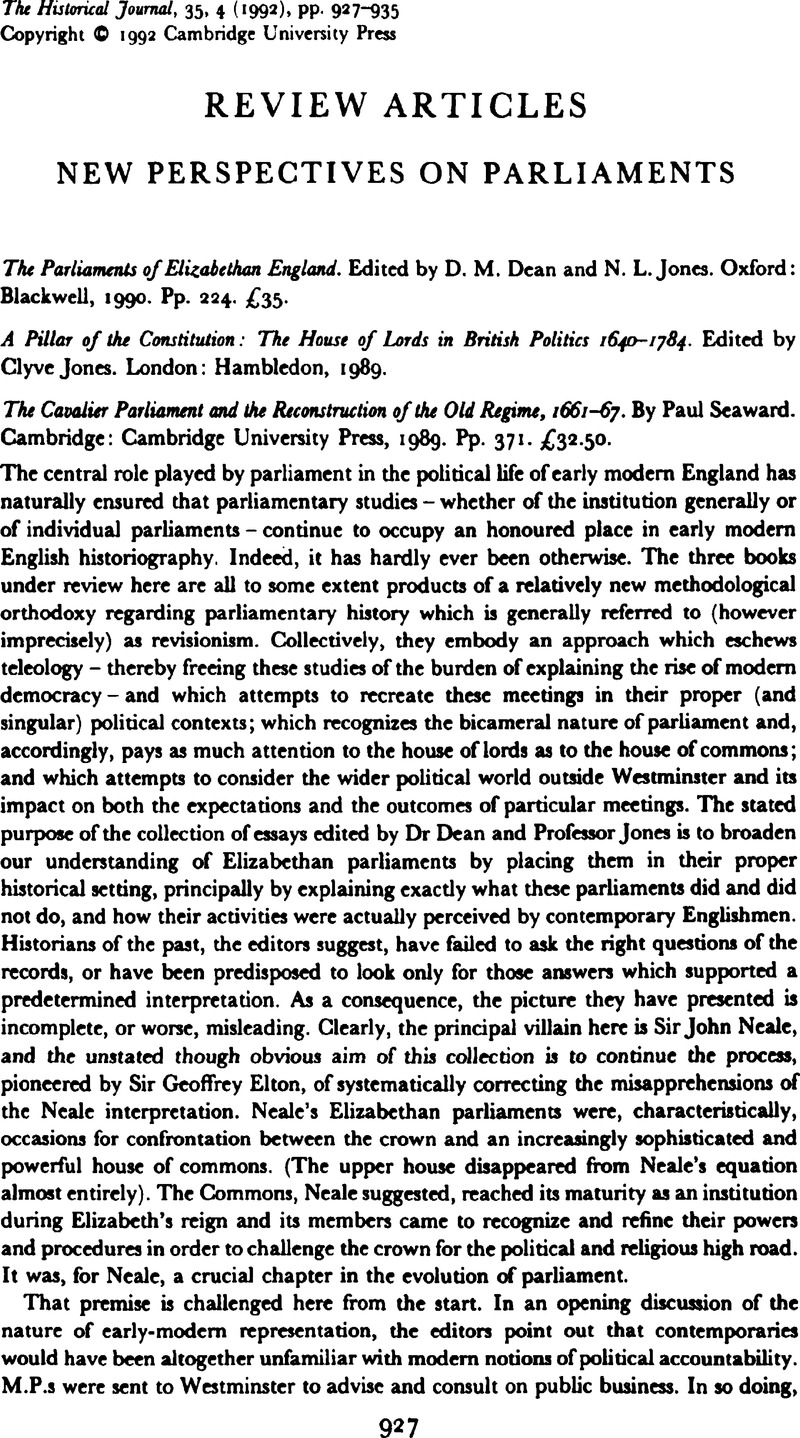No CrossRef data available.
Article contents
New Perspectives on Parliaments
Published online by Cambridge University Press: 25 March 2010
Abstract

- Type
- Review Articles
- Information
- Copyright
- Copyright © Cambridge University Press 1992
References
1 See, for instance, Elton, G. R., The parliament of England, 1559-1581 (Cambridge, 1986), pp.164–5CrossRefGoogle Scholar.
2 Peers, politics, and power: the house of lords, 1603-1911, Jones, C. and Jones, D. L., eds. (London, 1986)Google Scholar.
3 L(ords) J(ournal) V, 206, 208.
4 Ibid.
5 His claim is based, in this article, on a single citation of Mecunus Aulicus, 7th week (11—17 Feb. 1643/44), P. 828. Why Dr Adamson here prefers this source to citations from the Journals themselves - which bear directly on the matter - is not clear. Mecurius Aulicus was reporting these proceedings some weeks after they occurred. The report derived from a source whom Dr Adamson himself acknowledges (in this same article at n. 128) to be unreliable and which was, in any case, reporting at best second or third hand information. Surely the records maintained by the clerk of parliament or his assistants in the upper house, whatever their limitations, were bound to have been more accurate.
6 L.J., VI, 405. The proceedings on the ordinance on 1 February follow immediately after Essex's report of his discussion with the Scottish commissioners, and indeed, begin with the words ‘Hereupon, this House passed an ordinance to give Power to Committee of Both Houses… etc.’ The obvious implication is that Essex moved the ordinance. When this curiosity was recently pointed out to Dr Adamson by Professor Kishlansky (‘Saye what’, HJ, XXXIII (1990), 936–7)Google Scholar Dr Adamson claimed that Professor Kishlansky had misread the Journal, conflating two separate, unrelated entries (‘Politics and nobility in Civil War England’, HJ, XXXIV (1991), 252).Google Scholar The evidence flatly contradicts this assertion. It is true that in the Journal - printed many decades after the event -there is a small space between the paragraphs describing Essex's report and the introduction of the ordinance, but the two are clearly linked by the above cited language (‘Hereupon the House…’). More importantly, those separate paragraphs were in actual fact created by the printer of the Journal. In the original manuscript of the Journal, drafted by the clerk himself, there is no such spacing. Essex's report and the introduction of the ordinance are entered as a single paragraph, and indeed as part of a single extended sentence. There can be no doubt that they were part of a single process (H.L.R.O., original manuscript journals, vol. XXX, fo. 7, entry for 1 Feb 1643/4). It is true that the Journal entry does not specifically state who introduced the ordinance, leaving open the possibility that Saye could have been involved. However, the wording cited above strongly suggests otherwise and, perhaps more to the point, it would have been a striking (and highly uncharacteristic) failing on the part of the clerk not to have credited Saye - important as he was - had he actually been responsible for moving such a pivotal ordinance.
7 L.J., VI, 416.
8 Ibid. pp. 416, 418, 421-4, 426-7.
9 Ibid. p. 427.
10 L.J., VI, 428. Dr Adamson is incorrect when he suggests that it was William Strode who ‘carried the legislation to the upper House’ from the lower (p. 34 and note 69). Strode and others were delegated simply to carry a message to the upper house requesting that they expedite the ordinance, something which the Lords had already done the previous day. L.J., VI, 429. The Commons' version of the ordinance had been brought to the upper house a week earlier by Wentworth, Sir Peter. L.J., VI, 416.Google Scholar This was the only ordinance under consideration in the upper house in the month of February 1644.
11 That may well have been because his colleagues in the upper house had made it clear to him, in a formal resolution, that he would be free to appeal any order issued by the committee for both kingdoms with which he disagreed to both houses of parliament. L.J., VI, 426.
12 Cannon, John, The aristocratic century, the peerage of eighteenth century England (Cambridge, 1984). P. 95CrossRefGoogle Scholar.


